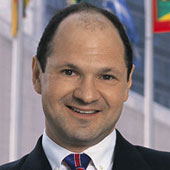Trump’s Foreign Soulmates
Look at commodities-export strongmen like Chavez and Putin if you want to understand Trump.
February 18, 2016
Foreigners see Donald Trump as one of those outlandish characters the New World periodically produces and then thrusts upon the international stage.
It is, however, far more than a bewildering one-man show. The rise of Trump underscores that we are witnessing a split of the United States of America into two distinct nations.
It is, perhaps, a return to form for a country that has often split politically (and once militarily) between its economically developed regions and its farm- or mineral-driven regions.
One of those two nations remains closer to the image that America has projected toward the outside world for nearly two centuries – an industrialized, highly innovative nation and a modern society that is open, liberal, tolerant and democratic.
The other America is once again displaying the characteristics of a commodity-exporting nation, as it did for much of U.S. history.
Poor role models worldwide
It is therefore only logical that — in order to understand Trump and above all the folks who cast their votes for him – it is fitting to look at other modern commodity-export-dependent nations, such as oil-rich Russia, Venezuela and so on.
Commodity exporting nations are a mess everywhere – from Algeria and Azerbaijan to Zambia and Zimbabwe.
They live off the distribution of free-flowing revenues which require a strong state. Friends and family of those who control the distribution obviously get a lot more. These nations tend to be ruled by charismatic strongmen who safeguard the interests of their cronies while feeding nationalist rhetoric to the masses.
Naturally, the masses hate immigrants and outsiders, because they represent additional mouths to be fed by crumbs from the strongman’s table. They are full of disdain for neighbors who aren’t fortunate enough to have natural resources in their soil.
Commodity exporters don’t need representative democracy, appointing their leaders by popular acclaim and very often for life.
Wither democracy?
When a commodity-exporting country runs out of its mainline commodity – as Indonesia and Mexico ran out of oil – or builds up an industrial base (as was the case in Chile), they gradually but unstoppably turn into representative democracies.
How does the United States fit into all this? After all, the country sometimes likes to describe itself as the world’s oldest continuous democracy.
Just consider the income inequality that prevails in the modern United States. The differentials are way bigger than in any other industrial democracy and stand at levels more in line with Third World commodity exporters. Is it any surprise that U.S. politics are moving in the same direction?
Trump, orator
Trump is masterful in working his crowds. He presses all the right buttons – the resentments and the fears of the masses of citizens of a commodity exporting country. Political pundits say he’s a new kind of politician, but he’s only new in America.
To find his antecedents, all you need to do is to look at the late Hugo Chavez in Venezuela or Vladimir Putin in Russia.
Chavez in particular is remembered for his hours-long teach-ins, often rambling, yet also often engaging, to the entire nation broadcast on live TV. That is not unlike Trump campaign events, which are really off-the-cuff chats with the audience.
Not surprisingly, Trump has already expressed his liking for good old Vlad, called him a real leader and expressed willingness to work with him.
As is the case with commodity-exporting nations, so it is with the United States. Both sport huge income differentials. And the rich like to use their enormous financial resources to perpetuate the status quo, mainly by buying the political system and getting their puppets elected rulers.
American oligarchs lose control
The surprise lies in how the super-rich in the United States have actually failed spectacularly in their endeavor. Consider commodity oligarchs such as the Koch brothers. They have been rigging the political system for years – only to see a man who’s totally outside their control within reach of their party’s nomination.
One is reminded of the parallels to Putin’s rise. The Russian oligarchs of the 1990s believed he would be a harmless pawn in their power games and he swept past them to take real control.
On the other hand, Trump’s appeal in American politics is considerable, but not limitless. In fact, it is limited to the part of the electorate that dominates the geographic sections of the country that most share the characteristics of commodity-exporting nations.
Sectionalism returns
These include mining country in Appalachia and the Mountain West; oil and gas country in Texas, Alaska, the Prairies and the rural Midwest; as well as agrarian swathes of the Deep South and Great Plains.
These regions have historically been cyclically dominated by populist firebrands espousing dangerously exclusionary views or ultra-wealthy authoritarians, who proudly perpetrated the abuses of slavery and segregation. It has been unusual to combine the two models.
While Trump also has some crossover populist appeal in the high-unemployment deindustrialized Rust Belt, these sections would probably align more heavily with the politics of Bernie Sanders, if choosing between the two.
To the still-industrial and white-collar remainder of the country, particularly in metropolitan areas, Trump is an alien presence altogether. They see the idea of voting for Trump basically as outlandish and preposterous as voting for Chavez or Putin to take the reins in the White House.
One nation under oil
What explains the sudden surge in support for the political style of a commodity-driven nation? It is convenient – and chronologically logical – to assume it is purely the result of discontent with the aftermath of the 2008 recession.
This might be a factor, but there was another key development almost at the same time, which cemented the rapid shift.
While the rest of the economy was limping from 2008 through 2012, there was a boom in U.S. oil and gas production, along with record-breaking farm and coal exports. All of this wreaked havoc on domestic prices, the value of the dollar and localized employment levels – most acutely in the regions where this production is centered.
Already some of these booms – coal and farm exports, for example – are dissipating as quickly as they arrived, but the effects will continue to be felt for some time.
Control of profits from and actual production of U.S. mineral extraction and farming in the 21st century is extremely concentrated in the hands of a few major corporations and the United States government.
This is a hybrid of the model of control in the commodity-driven nations, but it is concentrated almost the same.
Along comes a brash populist with an incipient cult of personality from his media empire. He promises economic stability and an end to foreigners competing for the crumbs of the profits.
He vows to bring “better management” to the joint cartel of Wall Street and Washington that – to the employees on the ground – appears to turn the money tap on and off at will, so he can keep the resources flowing and the jobs coming.
To see how this story ends – if he were to expand his appeal outside of mineral and farm country, thereby allowing him to win the presidency – look to the commodity-driven politics of the semi-developed, commodity-producer countries with strongmen leaders.
In other words, look at the examples of Chavez or Putin if you want to understand the rise of Trump.
Takeaways
Commodity exporting nations are ruled by charismatic men who safeguard the interests of their cronies.
In commodity exporting nations and the US, the rich use financial resources to perpetuate the status quo.
What explains a sudden surge in US support for the political style of commodity-driven nations?

